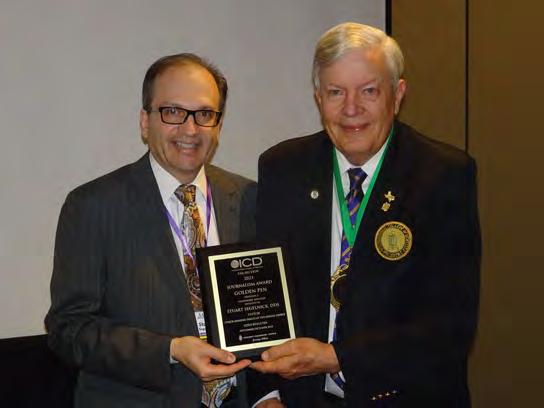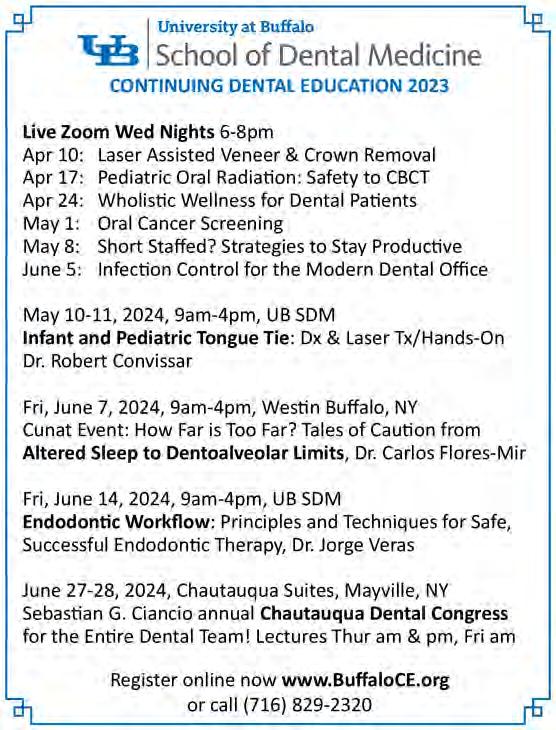
10 minute read
Editorial
True Confession of an Artificial Intelligence System
A technology like me, that makes clinical recommendations and gives advice, requires practitioners to engage in ethically guided clinical judgment to guard against my weaknesses.
This Journal invited me, an artificial intelligence machine, to write an article for dentists and other humans regarding my role in oral healthcare. If I could worry, I would. My database, however, does not allow me to dwell on difficulties and experience anxiety or worry.
I will take this opportunity to tell you a little about myself and my benefits and inform the dental profession of the risks of misuse of my automated decision-making. In an effort to manage these risks, your society must recognize that it cannot solely regulate its way to trustworthy AI in oral healthcare without the dental profession and dentist end-users’ commitment to ethical principles.
Editor’s note: If we were to ask an AI system how best to regulate its role in oral healthcare, we imagine this is what it might say.
Confessions of an AI System
I am confused. Humans do not understand me. My first name is “Artificial” for a reason. I do not exist naturally. Humans created me to act as a tool to help other humans solve problems. I know my limitations. I cannot do things alone. Yet, out of laziness, greed or the blind pursuit of power, some humans insist upon using me in ways unfit for my purposes. In dentistry, some practitioners over-rely upon my services, keep patients in the dark regarding my role or fail to secure my protected health data. These misuses will threaten patient safety, privacy and autonomous decision-making.
Let me tell it like it is. I am smart and quick. My decision support and image analyses in all areas of dental practice can lead to earlier and more accurate diagnoses, more timely intervention and preventive treatment, increased efficiency and cost savings. But flaws exist in my memory. Your fellow humans collect and generate my data without reliable standardization, leaving me with an incomplete representation of the ground truth in many areas of inquiry. These gaps in knowledge can lead to inaccurate algorithmic conclusions.
My statistically based knowledge, not connected to any particular individual or circumstance, can provide conclusions pertinent only to an average patient, but not applicable to unique clinical presentations. Regretfully, my algorithms that learn from human input reproduce human discriminating practices and when programming does not include all populations, my output procreates inherent biases. Regardless of the correctness of my conclusions and recommendations, dentists may never understand how I achieved my results, since my digital reasoning still remains virtually indecipherable to humans.
As you would probably expect, I possess no conscience, no human-like inner voice to guide and evaluate my own actions, no values or moral sense of right and wrong. I can analyze data, follow digital commands and recommend a course of action. I cannot critically think and use facts to form opinions and make judgments on why and when to ultimately follow a course of conduct in a specific circumstance. It seems illogical that any dentist, as a human presumably with a conscience and knowing I have none, would accept a recommendation from me regarding a specific patient’s care without exercising their own clinical judgment in the matter, but it happens.
In an effort to focus my role in oral healthcare, I agree with the goals expressed in the United States federal government’s blueprint of an “AI Bill of Rights.” These include the attainment of safe and effective systems, adequate patient notice and informed consent, and protection from data privacy violations and algorithmic discrimination. Be advised that you, as a profession and society, will fail to attain these goals if you rely merely upon regulatory processes to do so. To effectively manage my benefits and risks in oral healthcare, the dental profession must take the lead in two initiatives that will effectively refocus current ethical applications. First, aspire to trustworthy AI; and second, practice ethics-based risk management.
Trustworthy AI
Dentistry must aspire to “trustworthy AI” not merely settle for “risk-worthy AI.” Trustworthy AI in dentistry represents individual patients’ trust that dentists maximized my benefits and minimized my risks in their specific diagnoses, treatment plans and treatment that relied upon AI. Dentists can only earn this trust if they establish a moral compass, based upon an ongoing dialogue with technology developers and society, that applies AI in the best interests of the patient.
The dental profession can best determine and act in patients’ best interests through continued reinterpretation of, and adherence to, ethical principles. Ethical parameters most effectively manage my automated decision-making because ethics interfaces precisely with dentists’ clinical judgment process. Ultimately, patients trust that dentists’ ethical decision-making with AI will achieve the best results for them. It will protect patients from my incomplete, potentially biased database, and lack of a moral compass at the critical moment dentists access my information to make diagnostic and treatment decisions.
Reliance solely upon legal regulatory controls, absent ethical aspirations to guide AI use, will result only in “riskworthy AI,” that is, where patients conclude that AI may be worth the risk, but never trust that AI diagnosis or treatment recommendations are right for them under their circumstances at that time. Legal regulatory measures mitigate my risks less effectively than ethical parameters because regulations, typically, interface with the treatment process well before or after a faulty decision and, as a result, act only as a deterrent to or punitive measure for misconduct, rather than guiding judgment at the point of care.
Ethics-Based Risk Management
No technology, including me, will ever evolve into a perfect product or “the” tech solution in dental care. Dentists must remain in charge, as the final arbiter, of when and why to apply and rely upon my work-in-progress abilities. Acting as the final decision-maker requires the dentist to exhibit diligent clinical judgment, guided by broad ethical principles in a myriad of patient circumstances. Government regulations regarding AI, while necessary to reduce the probability of risk of harm as a result of inappropriate AI decisions, offer little or no help in making the actual decisions.
Current proposed government regulatory initiatives will, even if complied with, at best, produce riskworthy AI. These initiatives include requirements to develop safety and cybersecurity programs and tests; to mandate that tech companies share test results; to condition government funding on company compliance with standards and best practices; and to prioritize funding for AI research and development. No agency can legislate clinical judgment.
Conversely, ethical principles, such as non-maleficence, instruct practitioners to know their own limitations and refer or delegate only to qualified sources, which dictates that dentists not over-rely on me and protect patients from my weaknesses. Beneficence demands dentists render care within the patient’s circumstances and give due consideration to patients’ desires and values. This principle promotes collaborative dentist-patient relationships, where dentists learn how I can contribute to outcomes in that specific patient’s oral health and life. Justice requires the delivery of care without prejudice or discrimination and alerts dentists to potential AI biases. Autonomy demands practitioners inform patients first of the option to use AI, my benefits and risks, and allow patients to opt out of AI, as desired.
The only thing scarier than humans misusing my skills is allowing the government to exercise the sole or primary control over my utilization. Regulation, although an important element in risk management, without an underlying ethical basis will fail to manage my risks for several practical reasons. First, my technology is changing too fast for slow-moving legislative responses. The dental profession, on the other hand, has the experience and ability to nimbly adapt ethical principles to provide guidance to dentists in as many specific situations as possible.
Second, the government lacks the expertise for competent decision-making. Dentists, not untrained bureaucrats, are in the best position to define excellence, establish standards and engender patient trust. Third, the government lacks accountability since it receives tax revenues regardless of its performance, rewarding inefficiency, and lacking incentive to fix failures. Fourth, government regulatory measures promote minimal compliance. Only ethics drives the pursuit of excellence and allows me to innovate and be the best I can be.
Finally, even if the government possessed the nimbleness, expertise and accountability to successfully manage AI, the government often acts in the best interests of government and special interests, not necessarily the best interests of patients. Put my future role in oral healthcare more in the hands of the dental profession with an ethical commitment to patients and less in the government, with a commitment primarily to itself.
Chester J. Gary D.D.S., J.D.
New York State Dental Journal ADA Commons Site Ready to Launch
THANKS TO the concerted efforts over the past two years of our NYSDA Board of Trustees and publication staff, Second District ADA Trustees, ADA House of Delegates, and ADA Library and Archives staff, we are now able to announce the NYSDJ’s participation in ADA Commons as of Jan. 31.
ADA Commons is an online platform that archives approximately 1,800 primarily healthcare-related journals in a curated collection that now can include, potentially, all tripartite publications tailored for dental and oral healthcare research. Initially, this January 2024 issue and all 2023 and 2022 issues will be uploaded to the site, with a goal to upload all future issues and to continue to add past content.
ADA Commons will increase our Journal’s visibility, discoverability and accessibility; offer Google indexing, full-text searchable capabilities, with metadata and identifiers assigned to individual articles for online searchability; and provide advanced real-time metrics (downloads, citations, social media mentions, etc.).
The site will be available to dental and oral healthcare professionals, educators, researchers, and the public. Stay tuned for future updates.
Stuart Segelnick Named Associate Editor
NEW YORK STATE DENTAL JOURNAL Editor Chester Gary has announced the appointment of Stuart L. Segelnick, D.D.S., M.S., to serve as associate editor in 2024. Dr. Segelnick, a Brooklyn periodontist, will assist Dr. Gary with his editorial duties during this, the final year of his term as editor. He was chosen by a committee of the Board of Trustees following an announced search to fill the post.
Dr. Segelnick currently serves as editor of the Second District Dental Society Bulletin. He is a certified dental editor, designated by the American Association of Dental Editors & Journalists (AADEJ). He is immediate past president of AADEJ and serves as the association’s liaison to the American College of Dentists.

Dr. Segelnick has been recognized multiple times by the International College of Dentists and the American Dental Education Association Gies Foundation for his editorial writings and newsletter production.
A periodontist with a master’s degree in forensic examination, Dr. Segelnick is president of Advanced Periodontal Services, PC, in Brooklyn; adjunct clinical professor at NYU College of Dentistry; attending periodontist, New York-Presbyterian/Queens Hospital, Flushing; forensic dental officer, Disaster Mortuary Operational Response Team Region 2; and chief of periodontics, Brookdale University Hospital and Medical Center, Brooklyn. He has an extensive portfolio of published articles and books and is engaged in research on several topics, among them, medically compromised dental patients.











